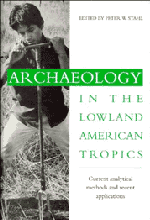Book contents
- Frontmatter
- Contents
- List of figures
- List of tables
- List of contributors
- Introduction
- 1 Archaeological survey and site discovery in the forested neotropics
- 2 The archaeology of community organization in the tropical lowlands: a case study from Puerto Rico
- 3 Archaeological methods for the study of ancient landscapes of the Llanos de Mojos in the Bolivian Amazon
- 4 Searching for environmental stress: climatic and anthropogenic influences on the landscape of Colombia
- 5 “Doing” paleoethnobotany in the tropical lowlands: adaptation and innovation in methodology
- 6 Plant microfossils and their application in the New World tropics
- 7 Differential preservation histories affecting the mammalian zooarchaeological record from the forested neotropical lowlands
- 8 Biological research with archaeologically recovered human remains from Ecuador: methodological issues
- 9 Interpreting dietary maize from bone stable isotopes in the American tropics: the state of the art
- 10 From potsherds to pots: a first step in constructing cultural context from tropical forest archaeology
- 11 Returning to Pueblo Viejo: history and archaeology of the Chachi (Ecuador)
- References
- Index
5 - “Doing” paleoethnobotany in the tropical lowlands: adaptation and innovation in methodology
Published online by Cambridge University Press: 23 November 2009
- Frontmatter
- Contents
- List of figures
- List of tables
- List of contributors
- Introduction
- 1 Archaeological survey and site discovery in the forested neotropics
- 2 The archaeology of community organization in the tropical lowlands: a case study from Puerto Rico
- 3 Archaeological methods for the study of ancient landscapes of the Llanos de Mojos in the Bolivian Amazon
- 4 Searching for environmental stress: climatic and anthropogenic influences on the landscape of Colombia
- 5 “Doing” paleoethnobotany in the tropical lowlands: adaptation and innovation in methodology
- 6 Plant microfossils and their application in the New World tropics
- 7 Differential preservation histories affecting the mammalian zooarchaeological record from the forested neotropical lowlands
- 8 Biological research with archaeologically recovered human remains from Ecuador: methodological issues
- 9 Interpreting dietary maize from bone stable isotopes in the American tropics: the state of the art
- 10 From potsherds to pots: a first step in constructing cultural context from tropical forest archaeology
- 11 Returning to Pueblo Viejo: history and archaeology of the Chachi (Ecuador)
- References
- Index
Summary
Archaeological research in the New World tropics has many different foci. Investigating the nature of subsistence practices in this diverse region, especially the transition to agriculture, figures prominently among these. However, recovering direct evidence of subsistence (for example, the remains of plants used by people), is a formidable challenge facing archaeologists who work in the neotropics. Preservation of macroremains (seeds, tubers, wood, corn cob fragments and the like) is limited to charred materials in all but the most arid settings. Even when charring occurs, macroremains may be highly fragmented due to expansion and contraction of soils, making their detection and recovery difficult during excavation. The problems of identifying such fragmented materials are rendered more complex by the high species diversity of the tropical flora. This necessitates a large botanical comparative collection and the occasional application of specialized identification techniques, such as scanning electron microscopy (Pearsall 1989).
Problems of preservation, recovery, and identification of botanical remains are not unique to paleoethnobotanists working in the neotropics, but the environments of the moist lowlands seem to “conspire” to create the worse possible conditions for recovering subsistence data. As Mangelsdorf remarked in his review of Agricultural Origins and Dispersals, in which Carl Sauer (1952) proposed the riverine zone of the moist tropical forest as a likely hearth of agricultural origins:
His two principal hearths occur in regions where few archaeological remains have so far been found and where the climate almost precludes the long-time preservation of herbaceous cultigens… Indeed if one sought, as an exercise in imagination, to design a completely untestable theory of agricultural origins and dispersals, it would be difficult to improve upon this one (Mangelsdorf 1953).
- Type
- Chapter
- Information
- Archaeology in the Lowland American TropicsCurrent Analytical Methods and Applications, pp. 113 - 129Publisher: Cambridge University PressPrint publication year: 1995
- 5
- Cited by

